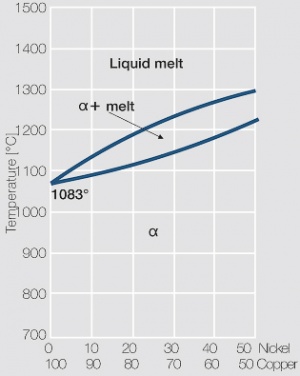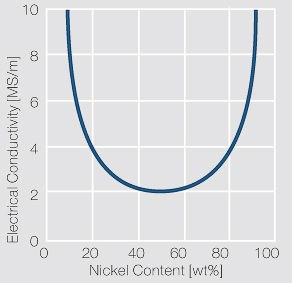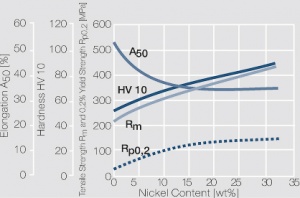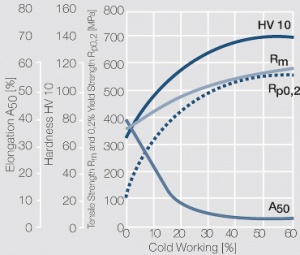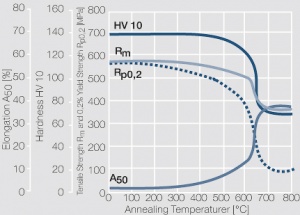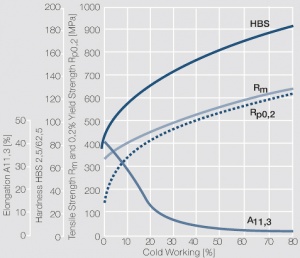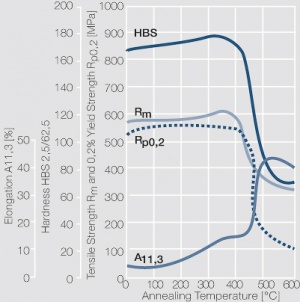Other Naturally Hard Copper Alloys
Copper-Nickel Alloys
Copper and nickel are in their solid and liquid phase completely soluble in each other Figure 1. Because of their very low electrical conductivity they are mainly used as resistance alloys Figure 2. The work hardening and softening behavior of CuNi alloys and CuNi9Sn2 are shown in (Figs. 3 – 7). Coppernickel alloys exhibit high corrosion resistance, good weldabilty, and the suitability for cladding to other materials. Because of these and their other properties Table 1 and Table 2 they are, with and without additives of iron or manganese, widely used as good weldable backing layers on weld buttons and weld profiles (weld tapes).
Copper-Nickel-Tin Alloys
Copper-Nickel- multi component alloys with 9 wt% Ni and 2 wt% Sn are used mainly as connector materials because of their suitable mechanical properties, their excellent relaxation behavior, and their high corrosion resistance. Other advantages include their high temperature stability and the good solderability even after longer storage. They are also used as base materials for clad profiles and tapes.
Figure 1 Phase diagram of copper-nickel for the range of 0 – 50 wt% nickel
Figure 2 Electrical conductivity of copper-nickel alloys as a function of nickel content
| Material Designation EN UNS |
Composition [wt%] |
Density [g/cm3] |
Electrical Conductivity |
Electrical Resistivity [μΩ·cm] |
Thermal Conductivity [W/(m·K)] |
Coeff. of Linear Thermal Expansion [10-6/K] |
Modulus of Elasticity [GPa] |
Softening Temperature (approx. 10% loss in strength) [°C] |
Melting Temp Range [°C] | |
|---|---|---|---|---|---|---|---|---|---|---|
| [MS/m] | [% IACS] | |||||||||
| CuNi25 CW350H C71300 |
Ni 24 - 26 Mn 0.5 Zn 0.5 Fe 0.3 Cu Rest |
8.94 | 3.0 | 5.2 | 33.3 | 29 | 15.5 | 147 | ca. 500 | 1150 - 1210 |
| CuNi9Sn2 CW351H C72500 |
Ni 8.5 - 10.5 Sn 1.8 - 2.8 Mn 0.3 Fe 0.3 Cu Rest |
8.89 | 6.4 | 11 | 15.6 | 50 | 16.5 | 140 | ca. 480 | 1060 - 1120 |
| CuNi10Fe1Mn CW352H C70600 |
Ni 9.0 - 11.0 Fe 1.0 - 2.0 Mn 0.5 - 1.0 Zn 0.5 Cu Rest |
8.92 | 5.6 | 9 | 17.9 | 50 | 16.5 | 134 | ||
| CuNi30Mn1Fe CW354H C71500 |
Ni 30 - 32 Mn 0.5 - 1.5 Fe 0.4 - 1.0 Zn 0.5 Cu Rest |
8.93 | 2.6 | 4 | 38.5 | 29 | 15.5 | 152 | 1180 - 1240 | |
| Material | Hardness Condition |
Tensile Strength Rm [MPa] |
0,2% Yield Strength Rp02 [MPa] |
Elongation A50 [%] |
Vickers Hardness HV |
Bend Radius1) perpendicular to rolling direction |
Bend Radius1) parallel to rolling direction |
Spring Bending Limit σFB [MPa] |
Spring Fatigue Limit σBW [MPa] |
|---|---|---|---|---|---|---|---|---|---|
| CuNi25 | R 290 | ≥ 290 | 100 | 30 | 70 - 100 | ||||
| CuNi9Sn2 | R 340 R 380 R 450 R 500 R 560 |
340 - 410 380 - 470 450 - 530 500 - 580 560 - 650 |
≤ 250 ≥ 200 ≥ 370 ≥ 450 ≥ 520 |
20 8 4 2 |
75 - 110 100 - 150 140 - 170 160 - 190 180 - 210 |
0 x t 0 x t 0 x t 1 x t |
0 x t 0 x t 0 x t 2 x t |
520 | 250 |
| CuNi10Fe1Mn | R 300 R 320 |
≥ 300 ≥ 320 |
≤ 100 ≤ 200 |
20 | 70 - 120 ≥ 100 |
||||
| CuNi30Mn1Fe | R 350 R 410 |
350 - 420 ≥ 410 |
≤ 120 ≤ 300 |
35 | 80 - 120 ≥ 110 |
1) t: Strip thickness max. 0.5 mm
Figure 3 Strain hardening of copper-nickel alloys as a function of nickel content
Figure 4 Strain hardening of CuNi25 by cold working
Figure 5 Softening of CuNi25 after 1 hr annealing after 50% cold working
Figure 6 Strain hardening of CuNi9Sn2 by cold working (Wieland)
Figure 7 Softening of CuNi9Sn2 after 1 hr annealing after 60% cold working (Wieland)
